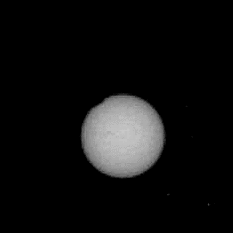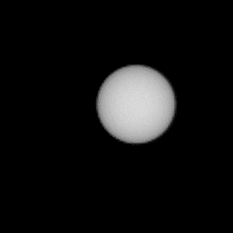Emily Lakdawalla • Aug 25, 2014
Cool animations of Phobos transits from Curiosity
Shooting video of a lumpy moon crossing the Sun and turning it into a giant googly eye is not a new activity for Curiosity, but I get a fresh thrill each time I see one of these sequences downlinked from the rover. A big pile of data from the most recent Phobos transit just landed on Earth, and I had to assemble them into an animation and share it with you. The animation runs faster than natural speed, but not a lot faster; Phobos transits take less than a minute. The data were taken on Curiosity's sol 713 (August 8), and downlinked just a couple of hours ago in the wee hours of Curiosity's sol 730. I believe I can see a pair of sunspots here, too, although they're a little hard to make out in the fuzz of the JPEG artifacts.
Note: an earlier version of this post had animations that were running backwards. Oops! I've uploaded fixed versions.

What do I mean by JPEG artifacts? When the Curiosity team shares its images with the public, they first adjust their contrast and convert them from a proprietary format to JPEG format. (Opportunity and Cassini do this too, and so will New Horizons.) JPEG is great for making images have small file sizes, but it is a "lossy" compression scheme that introduces artifacts, particularly in places where there are sharp edges between bright and dark things -- like the edge of the Sun against the much darker sky.
How much do JPEG artifacts affect the view? To answer that, I dug into the public Curiosity data for a transit that the rover observed just about a year ago, on sol 369. It's quite a bit crisper. You may also notice that Phobos looks a lot bigger. Phobos orbits so close to Mars that its apparent size changes dramatically, depending on whether you're looking at it closer to the horizon or overhead. (For more discussion of this and an explanation of what Phobos transit observations are useful for from Mars astronomer Mark Lemmon, read this blog post.)

I'll have to return to the sol 713 animation when its data are released publicly. Alas, we have just crossed a data-release boundary (data from sols 584 to 707 will be released on December 5), so I won't be able to get my grubby fingers on these data until March 16.
Support our core enterprises
Your support powers our mission to explore worlds, find life, and defend Earth. You make all the difference when you make a gift. Give today!
Donate

 Explore Worlds
Explore Worlds Find Life
Find Life Defend Earth
Defend Earth

